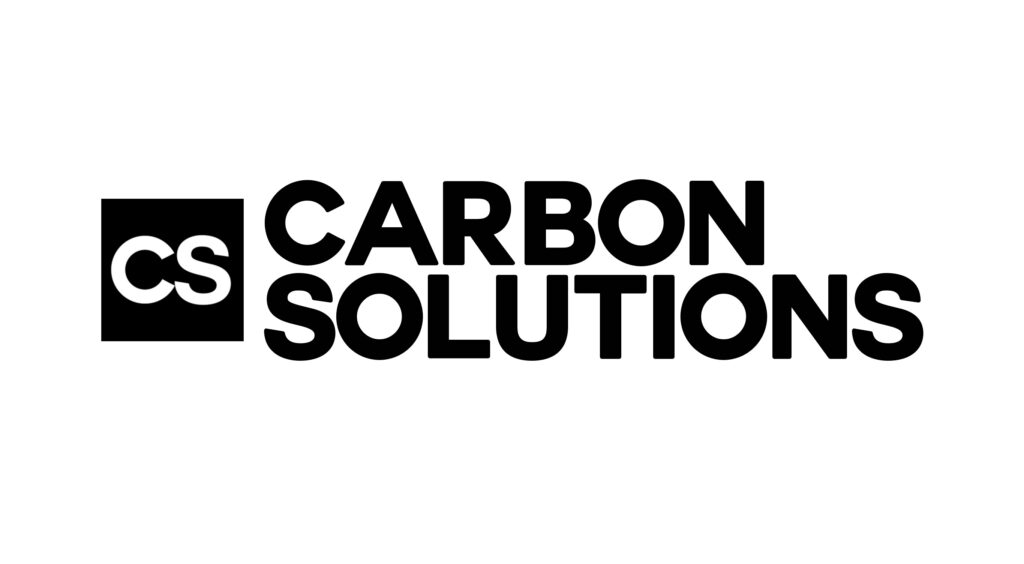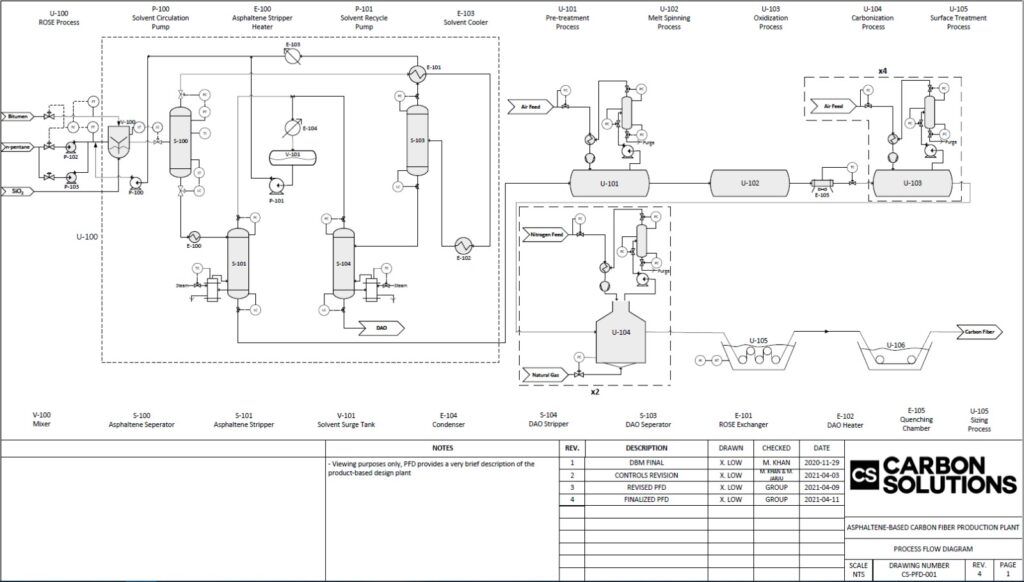Project Category: Chemical
Join our presentation!

About Our Project
The aim of this design project is to establish a novel process that uses bitumen-derived asphaltenes to produce a carbon product. An evaluation of various synthetic processes and the resulting product properties was conducted to determine the sustainability and application of asphaltene-based novel carbon materials. After conducting market research on carbon products, it was determined that carbon fiber (CF) would generate the most growth and demand. A novel process framework was then developed to extract asphaltenes from bitumen and convert them into CF.
The bitumen feedstock will undergo residuum oil supercritical extraction (ROSE), pre-treatment, melt spinning, oxidation, carbonization, and post-treatment to synthesize the fibers. Information from numerous literature sources has been analyzed and implemented for the most optimal and efficient design of the process. It has also been carefully constructed with reduced greenhouse gas (GHG) emissions and environmental impact in mind. The potential hazards and risks are identified and assessed, and the corresponding safety management and mitigation plans have been implemented.
A detailed economic analysis of this CF production facility yielded optimistic results for the future of this plant. The total capital investment is expected to be $77.9 million USD with an operating cost of $45.1 million USD/ year. The rate of return was calculated to be 22.1% with a 1.6 year payout period.
Meet Our Team Members

Details About Our Design
HOW OUR DESIGN ADDRESSES PRACTICAL ISSUES
The value of CF is apparent in the automotive, aerospace, and wind energy industries, where its strength-to-weight ratio is leveraged to improve performance and efficiency. Another notable distinguishing factor when comparing CF to its predecessor is that steel will deform at a stress level below its ultimate tensile strength, whereas CF cannot permanently deform. Overall, CF represents long-term value to the environment by lowering fuel, energy usage, and carbon dioxide emissions.
Currently, most industries manufacture CF using polyacrylonitrile (PAN) as a precursor. However, this is costly and limits the uses of CF to niche industries due to the lack of profitability in mainstream applications. Attempts have been made to use more inexpensive precursors, but doing so results in lower quality of CF.
The solution to the high costs associated with CF is the use of Alberta-based bitumen as feedstock in the production process. If the production cost of CF can be reduced to 5 USD/kg, the mainstream use of CF would be feasible. A barrel of bitumen-derived asphaltenes can be sourced for less than 1 USD/kg, as opposed to PAN which can cost between 9 – 15 USD/kg.
WHAT MAKES OUR DESIGN INNOVATIVE
Fort McMurray, AB is the optimal location for the CF manufacturing plant due to its close proximity with the CNRL Horizon Bitumen Upgrader and ease of accessibility to Athabasca bitumen. By localizing our production process and having suppliers within the city, we can expect an overall savings on design and transportation costs for shipment to the manufacturing plant.
The following process units have been designed to create a unique and innovative process for carbon fiber production:
Residuum Oil Supercritical Extraction (ROSE)
Implementing supercritical fluids and nanoparticle SiO2 in the extraction process results in a more innovative process design. The separation efficiency is improved with supercritical fluids by increasing the density difference between the extraction phase and the refining phase. SiO2 provides a high surface area to volume ratio and a large number of available active sites. This improves the removal of asphaltenes by selectively adsorbing asphaltenes onto the surfaces of the nanoparticles. The quality of deasphalted oil (DAO) is improved with a significant reduction in asphaltene and sulfur contents.
Oxidation-Stabilization
Oxidation-stabilization is the most complex, costly and energy consuming step of the CF manufacturing process. The processing time for industrial tow sizes of 24k can be greater than four hours for pitch-based CF which accounts for roughly 97% of the entire production process. Time reduction for this unit is significant as oxidation commonly uses up to 7.5 MW/hr to conserve a temperature range of 200-300°C. Pressurized air flow has been implemented to reduce the oxidation time of mesophase pitch to less than 60 minutes under air flow pressures of 0.5 and 1.0 MPa. The application of this method will result in a reduced stabilization time and yield a superior post-oxidation carbon fiber.
Melt Spinning
Increasing the melt spinning speed may result in poorer properties of the fiber such as reduced extendibility of the filaments. The modified threadline dynamics offer improvements in spinning performance at a higher take-up speed. Implementing a heating zone to the conventional threadline helps to increase the spinning speed limit. It modifies the usual decreasing temperature profile, therefore enhancing the fiber properties. With this modification, the take-up speed has been significantly increased while maintaining the good overall fiber properties.
WHAT MAKES OUR DESIGN SOLUTION EFFECTIVE
Our design solution is effective as we have found a way to create a superior carbon fiber product through the use of Alberta-based bitumen which has also proven to be economically viable. Every aspect of the design, from feedstock to final product properties, was carefully evaluated before being included. We achieved our desired goal of an improved Young’s modulus and tensile strength, as well as reduced overall cost of design while ensuring the project objective is achieved.
In order to create the most economically viable process, the deasphalted oil (DAO) produced from the ROSE process will be further processed and sold to generate a side stream of revenue in addition to the profit resulting from the manufactured CF.
CF production brings new investment, job creation, tax generation and other revenue. A manufacturing production plant of this desired capacity will add job opportunities within Alberta. This job provision will allow for a boost in Alberta’s economy and create a resurgence of people and community within Fort McMurray.
HOW WE VALIDATED OUR DESIGN SOLUTION
Through the research and compilation of many literature sources, each design unit has been carefully curated for its optimal performance and efficiency. As this is a product-based design project, the design factors were evaluated to determine the resulting effects on the final CF product. In addition, the credibility of the literature resources and process design is confirmed through regularly scheduled meetings with the TA and supervisor.
FEASIBILITY OF OUR DESIGN SOLUTION
- A production rate of 3,000,000 kg per year yields an annual revenue of $69,000,000 USD when the selling price of the final carbon fiber is $23.00 USD.
- The company is earning $17,257,262.73 USD annually in cash flow after accounting for expenses, initial investment, depreciation and taxes.
- The return on investment will be 22% and it will take approximately six years to fully pay off.
- The business becomes profitable at a selling price of $18.50 USD per kg of CF. However, $23.00 USD per kg allows us to have a competitive edge in the market and turn a sustainable profit. This will allow the company to invest in more processing plants for future growth and expansion.
Partners and Mentors
Carbon Solutions would like to thank the many people who have offered their support with this project. As a group, we are grateful for the continued mentorship of our supervisor Qingye (Gemma) Lu and TA (Dinesh Mishra) through the Fall 2020-Winter 2021 academic year. We would also like to extend our appreciation to Dr. Hector De la Hoz Siegler for his guidance and encouragement.
Our Photo Gallery



Results from Tensile Strength Test Modeling 
Fiber Orientation with Respect to Young’s Modulus 
Actual Tensile Strength Testing Results


